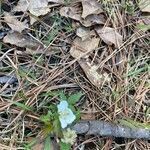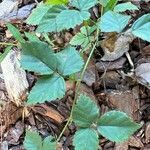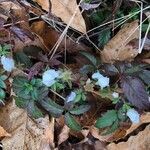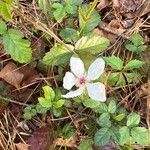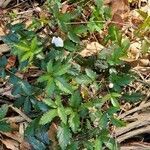Shrubs, to 3(–7) dm, ?sometimes climbing higher through other vegetation?, moderately to densely armed. Stems ?biennial?, initially low-arching, then falling and creeping (or climbing through other vegetation), glabrous or moderately hairy, sparsely to densely short-to long-stipitate-glandular, not pruinose; prickles moderate to dense, recurved, sometimes distally slender, 1–4 mm, broad-based; ?bristles absent or sparse to dense, erect to retrorse, red to purple, rarely green, slender, weak, gland-tipped?. Leaves persistent or semipersistent, ternate to palmately compound, ?lustrous?; stipules filiform, linear, or lanceolate, 2–12(–15) mm; leaflets 3–5, terminal narrowly elliptic or ovate to obovate, 2–8.5 × 0.7–4.5 cm, base rounded to cuneate, unlobed, margins moderately to coarsely serrate to doubly serrate, apex acute to acuminate, abaxial surfaces with hooked prickles on midvein, glabrous or sparsely to moderately hairy, eglandular or sparsely short-stipitate-glandular along central vein. Inflorescences terminal ?on short shoots, usually appearing axillary?, 1(–3)-flowered. Pedicels: prickles and, often, bristles moderate to dense, recurved, moderately to densely hairy, sparsely to moderately sessile-to short-stipitate-glandular. Flowers bisexual; petals white to pink, elliptic to obovate, 10–16(–25) mm; filaments filiform; ovaries glabrous. Fruits black, globose to ovoid, 1–1.5(–2) cm; drupelets 10–50, strongly coherent, separating with torus attached. 2n = 14.
More
Primocanes trailing, rooting at least at the tip, armed with a few short, stout, ± recurved prickles with expanded base, also hispid with many reddish glandular bristles; primocane lvs ± evergreen, 5-foliolate, on long, prickly petioles; lateral lfls sessile or subsessile; terminal lfl on a prickly and hispid petiolule a fourth to a third as long as the blade, mostly elliptic or oblong, a third to half as wide as long, serrate; flowering branches (excluding the peduncle) rarely over 1 dm, often only 1–3 cm, with a few small 3-foliolate lvs and commonly 1 (rarely 2) peduncles much surpassing the lvs. Chiefly in dry or sandy soil; Md. (?) and se. Va. to Fla. and Tex., n. in the interior to Mo. Apr., May.
The fruit are large, black berries.
Stream banks, roadsides, thickets and old fields. Dry sandy soils. Open woodlands, savannas, prairies, meadows, sand dunes, disturbed areas, dry to seasonally wet soil; at elevations up to 200 metres.
Can be grown by cuttings or seedlings. Seeds needs stratification.
